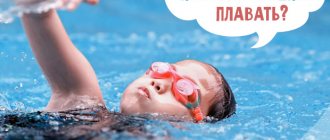Basics of proper swimming in various styles
Regardless of the age at which the skill is mastered, it is important to know: the correct body position is horizontal with the face lowered into the water . It is instinctive for a person to raise his head. But a lowered face helps maintain balance and prevents the cervical vertebrae from overworking during prolonged exposure to water.
This position increases buoyancy and increases speed in any style. Therefore, when you learn “from scratch”, it is better to immediately develop the correct position, so as not to waste time and effort on relearning.
Sports swimming has 4 styles:
- Butterfly . This style is not suitable for children who are just learning. It requires great physical effort and well-functioning coordination of actions. During the movement, the swimmer “flies” over the water, making simultaneous swings of his arms and a splash of his legs, similar to the movements of a dolphin.
- Breaststroke. The arms perform wide, “spreading” movements, and the legs seem to push off from the surface of the water.
- Crawl on the chest. The fastest style: the arms make sweeping strokes, and the legs perform alternating scissor-type swings. Most of the time the swimmer's face is submerged in the water. In this case, inhalation occurs while turning the head.
- Back crawl. The movements are identical to the previous style, only the swimmer is on his back. This is a clear advantage for children who are not comfortable putting their face in the water.
If you are not raising a professional athlete, you should not immediately accustom him to a particular style. First of all, you need to practice breathing, leg and arm work.
How to overcome your fear of water?
If a student is afraid of water, you should not convince him otherwise. To achieve quick results, it is important that classes take place in a comfortable and safe environment. Parents should focus not on overcoming fear, but on creating a feeling of safety. You can do this as follows:
- give the opportunity to get used to the water. When the baby looks around and is not distracted by new sensations, it is worth talking about the properties of water. In age-appropriate language, tell them that water, if the body is positioned correctly, will keep it afloat and “push” it to the surface. Show that the ball does not sink in water, explain why this happens. The absence of fear will allow you to achieve the desired result faster;
- let you feel the ground under your feet. Do not rush to immediately take the student into depth. The water level to the chest is optimal in the first stages of training. Invite the future swimmer to play games. The “Fountain” exercise helps you get comfortable in the water: bend your knees slightly so that your lips are in the water. In this position, you should blow out air with your mouth until bubbles form. This activity will certainly entertain the child and help cope with anxiety. In the future, you can go to a depth where the water level reaches the collarbones.
When teaching, it is important to remain calm, not to rush the child, and not to raise your voice. A parent should be a “lifeline”, a “guide” on the path to the unknown. When the fear of water is left behind, they begin to learn to stay afloat. You shouldn’t delay this moment, because you get used to being in the water, touching the bottom.
Stay calm and be a confident guide for your child, not only in learning to swim, but in any other situation. Always know where your child is and what is happening around him so that you can provide him with timely help or support. Download the “Where are my children” application from the AppStore and GooglePlay stores.
Games for teaching children 3-4 years old to swim
Games for the development and teaching swimming of children of primary preschool age
Author: Shinkareva Galina Gennadievna, physical education instructor, MADOU MAYACHOK, Nizhny Tagil.
In the work of a physical education instructor who conducts educational activities in the pool, it is necessary to take into account the individual and age characteristics of preschool children. So that classes in the pool have not only an educational function, as a means of learning to swim, but also the development of mental processes - memory, attention, thinking, perception, I use traditional and non-traditional types of work in my activities. In order to create a favorable emotional background and interest in the upcoming activity, I use musical accompaniment with different rhythmic patterns. Didactic games on water generate the greatest interest, response and results from students. In this regard, I developed a card index of didactic games that allow you to develop mental processes and consolidate swimming skills. I present to your attention several games from my library. “Mirror”
Goal: development of mental processes, improvement of swimming skills. Objectives: develop attention, visual memory, thinking; be able to reproduce what you see. Description of the game: children line up in a circle, a leader is selected who takes a place in the center of the circle. Holding hands, the children walk in a circle and say the words in unison: In an even circle, one after another, We go step by step, Stay still! Do this together with Dima! After the words, the children stop. The presenter shows a swimming exercise, and the children repeat the exercise. The leader chooses a new leader and the game repeats. Rules of the game: all exercises are performed simultaneously, while holding your breath.
“We are magicians”
Goal: development of mental processes, improvement of swimming skills. Objectives: to develop attention, auditory and visual perception, figurative memory, observation, logical thinking; consolidate the ability to freely immerse yourself in water while holding your breath and perform the “star” exercise; teach gliding on the water, improve footwork in the crawl style. Didactic material: cards with images of sea animals: starfish, seahorse, crocodile, crab, crayfish, fish.
Description of the game: the instructor invites children to play little wizards and learn to transform into various sea creatures. Showing a card with a picture of a sea creature, he offers to draw it. All exercises are performed while holding your breath while immersing yourself in water. Crocodile, crayfish, crab - moving along the bottom of the pool on your hands while immersing yourself in water while holding your breath (crawfish - moving backward, crab - moving sideways, crocodile - moving forward). Moving along the bottom of the pool on their hands, on command, children take a deep breath and lower their heads into the water. The winner is the one who holds his breath the longest. Seahorse - bending backwards with your hands to grab your legs. Starfish - lying on the water, holding your breath, arms and legs tense, spread apart. Medusa is the same, but the arms and legs are relaxed. Fish - gliding through the water, arms along the body, legs working in a crawl manner. To make it more difficult, you can suggest swimming into an underwater tunnel (a hoop is lowered under the water). Rules of the game: we perform all transformations using a whistle, you cannot wipe your eyes with your hands, you can blink your eyelashes. When children learn to correctly perform all swimming movements, you can play a variation of this game “Guess the riddle” . The instructor asks a riddle, and the children show the answer. 1. I’m sitting in the shallows, I’m moving my mustache I’m walking backwards ( crayfish ) I live on the bottom of the sea, with a strong shell on top, I’m like a spider, I’m walking sideways on the sand ( crab ) 2. Here’s a green log that floated down the river. If this river is the Nile, then there is a log in it... ( crocodile ) 3. A transparent umbrella floats. “I’ll burn you!” Don't touch me! My paws are from my belly. What's my name? ( jellyfish
) 4. Deep at the bottom it is visible as if in the sky.
But it doesn’t shine and doesn’t warm, Because it doesn’t know how. ( starfish
) 5. I look like a horse, And I live in the sea too.
I jump briskly, jump and jump - My name is sea... ( horse ) 6. I swim under the bridge And wag my tail. I don’t walk on the ground, And I don’t speak at all, I have eyes, but I don’t blink, I have wings, but I don’t fly ( fish
)
“Scuba divers”
Goal: to develop memory, observation, auditory perception, to teach diving under water with your head and eyes open, to develop the ability to act in concert with a partner. Description of the game: children are divided into pairs and hold hands, at the same time squatting, immersing themselves under water, opening their eyes and looking at each other. Rules of the game: perform the dive only at the command of the instructor; after emerging from the water, do not wipe your face with your hands, and blink your eyes.
“Treasure Seekers”
Goal: development of mental processes, improvement of swimming skills. Objectives: develop visual memory, voluntary attention, logical thinking, fine motor skills, dive under water while holding your breath. Didactic material: sinking small and large objects of different colors. Game description: children dive and retrieve objects from the bottom of the pool. Task options: “Pick up large objects in the red container, small ones in the blue.” “Lift a certain number of objects.” “Pick up an object of a certain color.” Rules of the game: you need to dive while holding your breath, open your eyes under water, find one object and deliver it to the container.
When children have mastered most of the swimming exercises, you can organize the game “Dancing on the Water.”
Goal: development of mental processes, improvement of swimming skills. Objectives: to develop imagination, memory, attention, the ability to determine the nature of music and select movements. Didactic material: inflatable balls, hoops, flowers. Description of the game: the task is to prepare the performance of synchronized swimming athletes. Children independently come up with joint movements and swimming exercises, depending on the nature of the music. Rules of the game: complete independence. The use of didactic games in classes in the pool helps children become familiar with the variety of movements in an unusual environment, develop activity and independence in performing them, and develop creative orientation.
We recommend watching:
Determination of leading links at an early stage in young swimmers Reserves for increasing the efficiency of leg movements in sports swimming Improving the technique of underwater movements after performing starts and turns in sports swimming Adaptation mechanisms and risk factors when diving underwater while holding your breath
Similar articles:
Games for teaching swimming to children 4-7 years old


